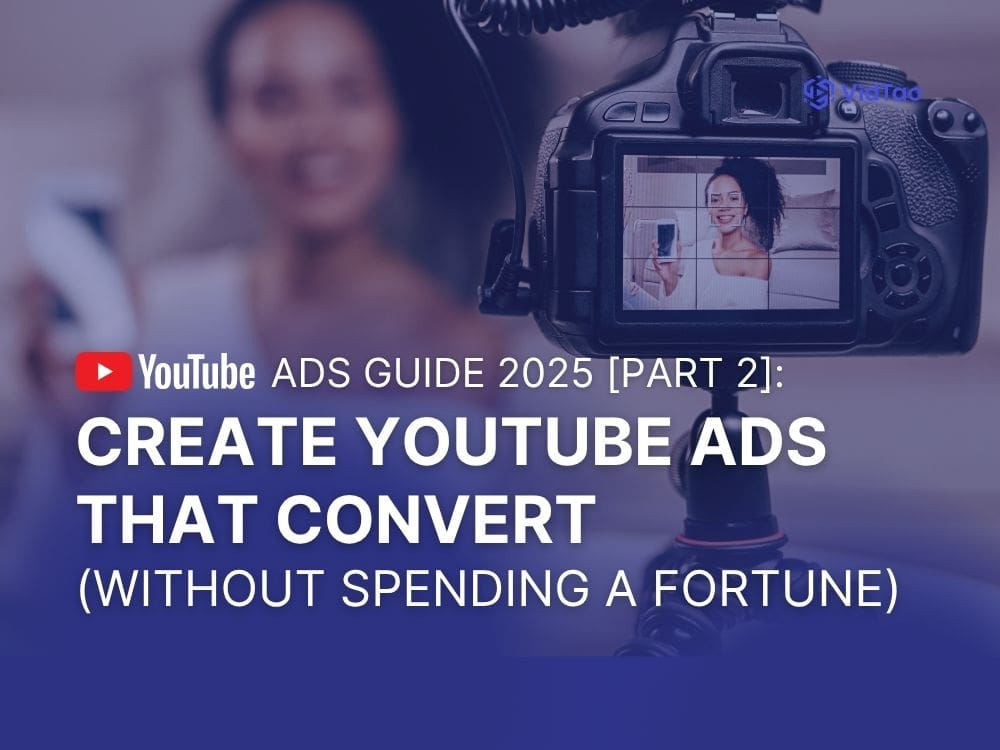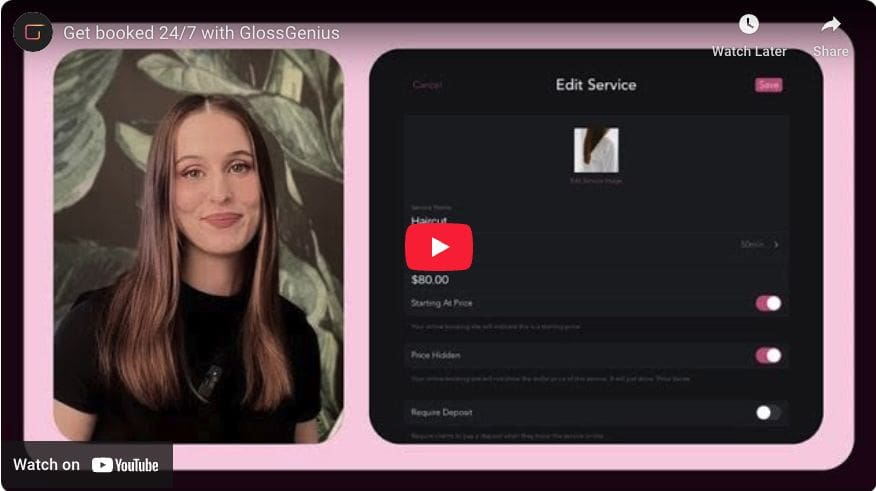In Part 1 of this guide, we showed why YouTube is the top ad platform for 2025—with stable CPAs, intent-based targeting, and unmatched viewer attention.
Now in Part 2, it’s time to get tactical.
This guide is designed specifically for direct response marketers—whether you’re new to YouTube or looking to scale smarter. You’ll learn how to create ads that convert, even if you’ve never filmed a video before.
And here’s the good news: you don’t need a studio, a crew, or a big budget to pull it off.
Some of the best-performing YouTube ads we’ve seen on VidTao this year were shot on a phone in someone’s kitchen. No fancy gear. No actors. Just a clear, honest message delivered in a way that feels real.
Here’s what we’ll cover in this step-by-step guide:






Everything here is backed by data. We’ve analyzed millions of YouTube ads inside VidTao to uncover what’s actually working right now—across niches, budgets, and ad formats.
So let’s dive in!
What Actually Makes YouTube Ads Work (Hint: It's Not What You Think)
What’s the difference between a YouTube ad that makes you want to buy something and one that makes you hit “Skip Ad”?
It’s not the graphics. Or the studio lighting. Or some perfectly color-graded b-roll.
It’s this: The best YouTube ads feel like helpful conversations, not ads.
Picture this: you’re on YouTube, searching for a way to grow your business. A video starts, but before it plays, an ad pops up. A woman says:
“I’m going to show you how easy it is to create a website for your salon or spa business that looks this polished.”
That’s the opening line of a Gloss Genius ad we found inside VidTao, and it’s a perfect example of this principle in action.
It doesn’t feel like a pitch, it’s like a tutorial. A real person, speaking directly to a real problem. No hard sell, no fluff.
And because it leads with value, not hype, it earns attention.
That’s the unlock: when your ad speaks to what someone actually cares about—in clear, unscripted language—it stops the scroll. It makes people listen.
Connection beats perfection. Every time.
Why Your Script Is Your Secret Weapon
Here’s the truth: no amount of fancy visuals can fix a weak script. But a strong script? That can carry an ad shot on an iPhone straight to the top of your campaign dashboard.
We’ve seen this across thousands of winning campaigns inside VidTao. The winning campaigns don’t rely on flashy production. They rely on structure.

Almost every ad we've seen crush it on YouTube follows the same simple 4-part framework that you can replicate in your own ads. Here’s how it works…
The 4-Part Structure Every High-Converting YouTube Ad Uses
This approach is like a recipe: once you know the ingredients and the order, you can cook up winning ads over and over again.
Here’s the formula:
1. The Hook (First 5 Seconds)
This is everything.
Your hook decides, within seconds, whether someone watches or skips. And if they skip, nothing else matters.
The best YouTube ads open like a story you have to hear: bold, relevant, and impossible to ignore.
Top media buyers spend more time testing hooks than anything else. Because if the hook doesn’t land, the rest of the ad never gets seen.
Why Hooks Matter So Much
A great hook isn’t just attention-grabbing—it pulls quadruple duty:
- Stops the scroll with surprise, pattern-interrupts, or direct relevance
- Triggers curiosity by teasing a hidden truth, result, or transformation
- Signals value by framing a pain or desire the viewer cares about
- Qualifies the audience by calling out a specific group or struggle
That’s why top YouTube advertisers never launch with just one hook. They test 3, 5, even 10 variations for the same ad. Different hooks for the same video body — same message, new first impression.
The VidTao Hook Strategy
Instead of guessing what works, use VidTao to reverse-engineer what’s actually performing right now:
- Search for ads in your niche
- Filter by “Most recent” to see today’s winners
- Watch just the first 5-10 seconds — that’s where the magic happens
- Use the “Swipe” button to save ads with strong hooks to your library
- Look for patterns in tone, structure, pacing, or visuals, then riff off them in your own ads
The answers are already out there. VidTao lets you find them fast.
Good vs. Bad Hook Examples


















See the difference?
Proven Hook Types You Can Start Testing Today
- Direct Problem Callout
“Still waking up exhausted even after 8 hours of sleep?”Relatable + emotionally charged
- Contrarian Insight / Myth-Busting
“If you think walking 10,000 steps a day burns fat—someone lied to you.”
Curiosity + belief disruption
- Personal Mini-Story
“I spent $2,000 on therapy before I found this free tool…"Builds trust + previews payoff
- Bold Claim or Teaser
“This little-known breathing trick helped 7,000+ people sleep through the night.”Suspense + social proof
- Targeted Callout
“If you’re over 40 and trying to get back in shape—this is for you.”Filters in the right viewer instantly

Try Hooksmith GPT — a free AI tool our agency built specifically to help media buyers, founders, and copywriters crank out high-converting short-form hooks in seconds. Use it to brainstorm fresh angles, punch up weak intros, and keep your top-of-funnel creatives performing longer.
Pro Tips for Hook Testing
- Start each campaign with 3–5 hook variants for the same video
- Keep everything else the same (script, visuals, CTA) to isolate performance
- Watch metrics like watch time and skip rate — if a hook holds past 10 seconds, you’ve got something
- Scale what works. Kill what doesn’t.
- Keep rotating in fresh hooks. Ad fatigue is real, and fast.
2. The Problem (10-15 Seconds)
Once you’ve grabbed attention, your next move is to deepen the emotional grip. That means showing your viewer you get them before you ever pitch a solution.
The best YouTube ads do this by naming the exact pain the viewer is feeling, in words they’d actually use.
But to write this part well, you need to know your audience inside out:
- What are they frustrated with?
- What have they already tried (and failed)?
- What are they secretly embarrassed about?
This is where research matters: dig through customer surveys, Reddit threads, YouTube comments, or competitor reviews until you can describe their pain better than they can.
Generic frustrations won’t cut it. You have to get specific, get personal. Dig into your target audience’s deepest, darkest insecurities and desires to make them feel seen.
Instead of: “Struggling with marketing”
Instead of: “Having neck pain”
Instead of: “Trouble sleeping”
The goal is to make your viewer say, “Wait…that’s me.”
That’s how you earn their trust and keep them watching.
3. The Solution (20-40 Seconds)
Now it’s time to introduce your product — but don’t start rattling off its features.
Instead, paint a transformation, a before/after moment. Help the viewer think: “That could be me — and that’s who I want to be.”
Think:



These lines work because they sell the outcome. They focus on the win: the result your viewer wants delivered in natural, relatable language.
But how do you write something like that? Here are a few battle-tested frameworks to help:
 Direct Response Copywriting Frameworks That Actually Work
Direct Response Copywriting Frameworks That Actually Work
1. Problem–Agitate–Solve (PAS)
Start by stating a key problem your viewer is struggling with. Then go deeper — describe how that problem feels on a daily basis. Make it personal. Make it sting a little. Finally, pitch your product as something that brings relief.

2. Before–After–Bridge (BAB)
Show what life was like before the product — specific, frustrating, maybe even a little embarrassing. Then paint the clear “after” transformation. Finally, reveal how your product made that shift possible.

3. Features–Advantages–Benefits (FAB)
Mention one key feature, explain what that enables, then show the real-world benefit.

4. AIDA (Attention–Interest–Desire–Action)
Keep the viewer engaged with a mini-narrative: hook them again, build interest, spark desire, and lead to CTA.

5. The 4 P’s (Promise–Picture–Proof–Push)
Make a bold promise, paint a vivid picture, show proof, and end with a nudge.

You don’t need to follow these formulas word-for-word, but knowing them helps you write stronger, clearer solution copy faster.
The key is to sell the outcome, not the product.
4. The Call-to-Action (Last 5-10 Seconds)
You’ve grabbed attention, built trust, and shown the transformation your product can deliver. Now comes the moment of truth: getting the viewer to take action.
And if your ad has done its job, the viewer wants to take the next step.
But if the CTA is confusing, vague, or too demanding, you’ll lose them right at the finish line.
Your CTA should be:
- Clear: Say exactly what to do
- Low-friction: Don’t ask for too much too soon
- Value-focused: Make the benefit of clicking obvious
Examples that work:



The right CTA feels like the obvious next step, not a hard sell.
The Psychology of Effective CTAs
Your CTA is the bridge between attention and action. Make it complicated, and people won’t cross. Make it effortless, and they’ll click without hesitation.
Here’s what makes a CTA convert:



The best CTAs remove friction, spark action, and make clicking feel like the obvious choice.
CTA Formulas That Convert
- Free Value: “Click below to get your free [valuable thing]”
- Trial/Demo: “Start your free trial today”
- Learn More: “Click to learn how this works”
- Limited Time: “Get instant access before we close enrollment”
- Social Proof: “Join thousands of people who are already [achieving result]”
Common CTA Mistakes to Avoid
- Too Many Options: One clear action > three confusing ones.
- Weak Language: “Maybe consider checking this out.” ≠ “Get your free guide now.”
- Mismatched Expectations: If you promise a free guide in the ad, don’t bait-and-switch with a sales page. Deliver exactly what you said.
YouTube-Specific CTA Tips
- Be Mobile-Friendly: Most viewers are on their phones. Make it easy to tap—not scroll.
- Match Your Landing Page: Your CTA should lead to exactly what you just pitched. Any disconnect hurts trust (and conversions).
- Keep It Tight: You only have 5–10 seconds. Every word matters.
If you want to see how these principles play out in real, high-performing YouTube ads, the VidTao blog is packed with weekly breakdowns, swipeable hooks, and campaign insights you can use right away.
Real Ads, Real Results: See What’s Working Now
If you’re new to copywriting and struggling to understand how all this fits together, study real ads that are already working.

It’s packed with over 100 top-performing YouTube ads and landing pages from 2025 and updated weekly. These are real-world examples of ads that convert — ready for you to model, adapt, or get inspired for your next campaign.
The Simple, Budget-Friendly Production Formula That Actually Scales
Ad fatigue is real. One winning creative won’t cut it—you need fresh ads on repeat to keep scaling. But traditional video production? It’s expensive, slow, and if you’ve never made an ad before, it feels downright overwhelming.
But here’s the good news: You don’t need anything fancy to create an ad that performs.
The savviest YouTube advertisers — whether they’re spending $50 a day or $50k a month — use this one simple, repeatable formula:

This isn’t some second-rate hack. We’ve seen countless seven-figure ad accounts inside VidTao use nothing more than a solid script, a clear voiceover, and relevant visuals. When done right, it’s not just good enough — it outperforms most polished, high-budget productions.
Here’s how to build these winning creatives fast, and on a tight budget:
Step 1: Record Your Voiceover
Forget studio time. Your iPhone mic or built-in laptop audio is more than enough. What matters most is how you sound.
Talk like you would to a friend. Conversational tone converts. Avoid the stiff “announcer voice” or overly scripted delivery. If you want an alternative to recording yourself, AI tools like ElevenLabs or HeyGen let you input your script and instantly generate realistic voiceovers.
Want your own voice to sound studio-grade without a studio? Just run your raw audio through Adobe Podcast’s Enhance Speech tool. It automatically removes background noise, balances your tone, and adds that clean, warm polish that makes your voice ad-ready.
Step 2: Gather Your B-Roll Footage
Think of B-roll as your ad’s visual support system. You’re not trying to impress — you’re trying to communicate clearly. The goal is to show what you're talking about in a way that feels natural and visually relevant.
Where to find solid B-roll:
- Pexels - Free, high-quality clips for just about any niche
- Artgrid - Premium stock footage (paid)
- Storyblocks - Unlimited downloads for a monthly fee
- Envato Elements - Unlimited premium stock in one subscription
- Your phone - DIY shots of your product, screen recordings, or user clips work great
Don't overdo it. Clean and simple visuals that reinforce your message are all you need.
Step 3: Edit It All Together
You don’t need to be a video editor to pull this off. Here are a few beginner-friendly tools we recommend:
- CapCut - Fast, free, and beginner-friendly
- Descript - Edit video by editing text
- Canva - Beginner-friendly video editor in your browser
- iMovie - Already installed on most Macs
Pro tips:
- Stick to simple transitions – straight cuts work better than flashy effects
- Sync visuals with what’s being said
- Keep the pace snappy and focused
Always add subtitles. Even the best hook or strongest pitch can be lost if people miss the message, especially on mobile, where sound is often off by default. Plus, some viewers just process visual info faster. Both CapCut and Descript make it effortless: they’ll auto-generate captions directly from your audio and sync them perfectly with your visuals. No extra tools or manual syncing required.
This formula is perfect for testing lots of creative angles fast, without draining your budget. And when you're running YouTube ads in 2025, speed and volume are key.
Want proof? Check out how top-performing YouTube Shorts ads keep things scrappy and scale anyway.
More production ≠ more performance. This simple voiceover + B-roll combo just works.
How to Polish Your YouTube Ad So It Connects and Converts
You've got your voiceover. You've got your visuals. And you've stitched them together into a working ad. Now it’s time to level it up.
This is where you refine the edit so it feels smooth, natural, and emotionally on point, especially for viewers seeing your brand for the first time.
These aren’t just technical tweaks. They’re the subtle creative choices that turn an ad from “just fine” to “this speaks to me.”
If your ad isn’t converting like it should, chances are the problem lives here. The following quick fixes will help you spot what’s off and tighten it fast.
Here’s how:
 Use Visuals That Feel Familiar to Your Audience
Use Visuals That Feel Familiar to Your Audience
Great editing starts with empathy. Before choosing any B-roll, ask: “Would my target customer see themselves in this scene?”
- Selling to suburban moms? A cheerful family kitchen beats a sterile studio.
- Targeting young professionals? A cozy home office or local café reads better than generic skyscrapers.
- Promoting to middle-aged men? Avoid visuals they couldn’t justify watching next to their partner. A testosterone ad featuring modest health-focused content is safer (and more watchable) than glamorized visuals that could raise questions.
This kind of environmental and emotional filtering ensures your ad doesn't get skipped because it feels off.
 Edit for the “Muted Viewer”
Edit for the “Muted Viewer”
Not every viewer will hear your ad, but they should still understand it. Make your message clear even with the sound off:
- Add bold captions for key lines
- Use arrows, circles, icons, and text overlays to highlight important points
- Visually reinforce what’s being said in the script
- Test your edit on mute: Can you tell what the ad is about without audio? If not, tighten the visual storytelling.
 Match Clips to Script Meaning
Match Clips to Script Meaning
Each visual should match what’s being said in the voiceover. This seems obvious, but many ads go off-script visually. For example, if the line says “I was frustrated trying every skin serum under the sun,” don’t cut to a smiling woman applying makeup in perfect lighting. Cut to cluttered bottles, tired eyes, maybe even someone returning a product.
Visual congruence builds trust. Mismatch kills it.
 Match the Viewer’s Environment and Demographics
Match the Viewer’s Environment and Demographics
If you’re targeting the US, don’t show streets and homes clearly shot in Eastern Europe. Watch for small cues: architecture, furniture, license plates, even fashion. Your audience subconsciously spots these inconsistencies. Aim for footage that feels local and familiar.
That includes:
- Environment: Homes, cities, cars, stores, and real-life spaces
- Demographics: Show a representative mix of ethnicities based on who your ad is targeting
- Emotion: Make sure facial expressions feel genuine. Avoid fake stock reactions, as they stand out for the wrong reasons.
Need a shortcut? Use this visual checklist from Inceptly to audit your edit for relevance and believability.
Final tip: Don’t forget about color. A subtle blue tint can make a scene feel cold. A warm filter can imply comfort or safety. Use color intentionally to support your emotional message.
Real Success Story: One of our VidTao users analyzed successful ads in the productivity niche and noticed they all used simple screen recordings showing the software in action, combined with conversational voiceovers. She created her own version using free screen recording software and a $20 USB microphone. The result? Her first YouTube ad campaign generated over $50,000 in sales with a simple B-roll + voiceover approach.
YouTube Ad Thumbnails & Titles That Drive Clicks (And Lower Your Costs)
While most YouTube ads run as in-stream skippable videos, there’s another format you can’t ignore — discovery ads.
These appear in search results and suggested video feeds, just like organic content. That means your thumbnail and title have to do the heavy lifting. Think of them as your storefront window: clean, bold, and built to spark curiosity.
The Psychology of Thumbnails
What makes you click on one YouTube video over another?
Usually, it's not luck — it’s a combination of strong visual cues and curiosity-driven copy. That same psychology applies to discovery ads.
Great thumbnails do three things:
- Stop the scroll – via contrast, movement, or emotion
- Signal value – by reinforcing a clear benefit or pain point
- Set the tone – so the viewer knows what kind of content to expect
Thumbnail Best Practices (Visual & Technical)
If you're creating thumbnails for your discovery ads (or for public YouTube campaigns), follow these rules:

- Keep it simple: Cluttered designs kill click-throughs. Focus on one idea.
- Use faces: Human faces (especially with expressive emotion) draw attention fast.
- High contrast: Make your image stand out against YouTube’s white background.
- Bold text overlay: Use short, sharp phrases that support your hook (4-5 words max).
- Preview it small: Zoom out to 25% and check if it’s still legible — most views come from mobile.

- Recommended Dimensions: 1280×720 pixels
- Minimum Width: 640 pixels
- Aspect Ratio: 16:9 (YouTube standard)
- File Types: JPG, PNG, or GIF
- Max File Size: 2MB
How to Write YouTube Ad Titles That Get Clicks
Your title should work hand-in-hand with your thumbnail to tease the value of the video. Use one of these proven structures:
- How-To Format: “How to Build Muscle After 40 (Without the Gym)”
- Mistake Format: “The #1 Mistake New Moms Make With Sleep Training”
- Secret Format: “The Secret Fat-Burning Trick Doctors Won’t Mention”
- Results Format: “How I Cleared My Skin in 7 Days Using This”
Keep titles under 60 characters when possible, since YouTube truncates longer ones in mobile results.
Not sure what style fits your niche? Use VidTao’s ad library to instantly scan what’s working across your market.
With VidTao, you can:
- Browse thumbnail designs by industry or offer type
- Identify engagement trends (e.g. faces vs. product shots, dark vs. light palettes)
- Filter by most recent or highest spend to see what’s performing today
- Swipe and save ads with successful thumbnails to build your creative swipe file

Real Examples of Thumbnails That Performed
Here are 2 thumbnail examples from high-performing YouTube ad campaigns. You’ll notice they follow the principles outlined above: bold visuals, clean text overlays, and emotional cues to drive clicks.



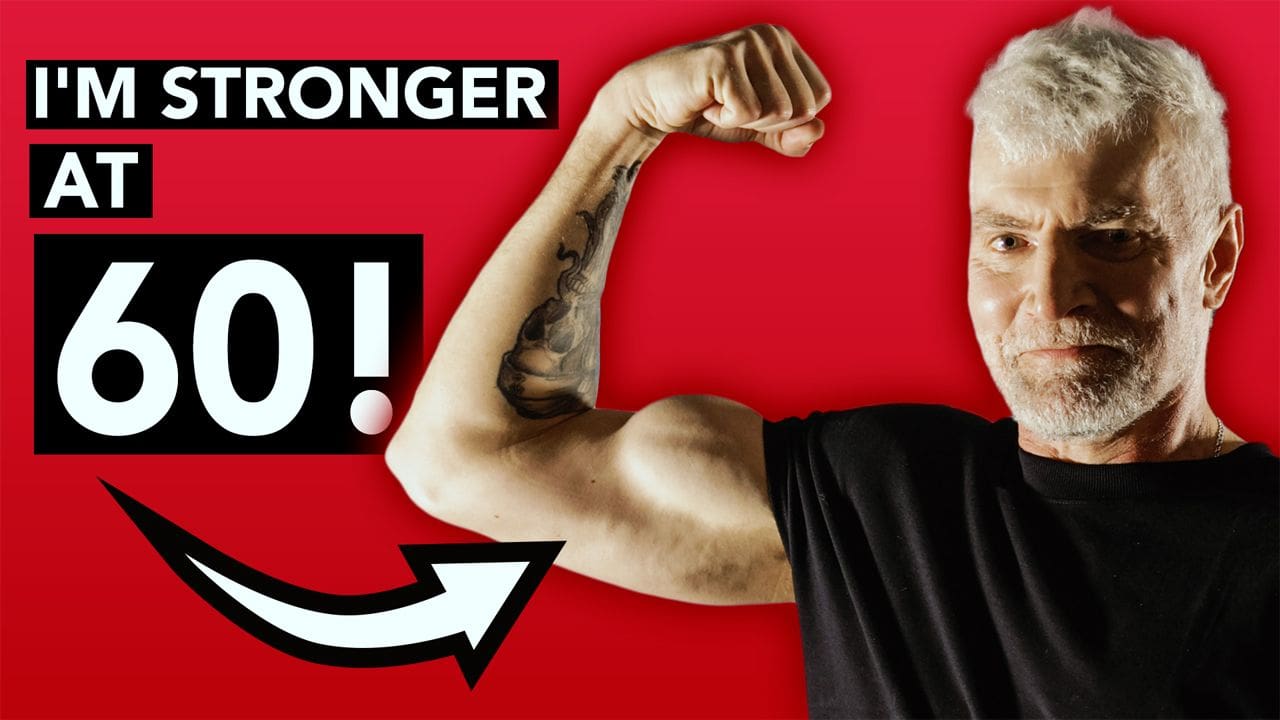
These examples show how simple design + emotional storytelling can outperform complex visuals, especially when your thumbnail supports a strong hook.
Launching Your First YouTube Ad: How to Set Up a High-Impact Demand Gen Campaign on YouTube
You’ve got the creative. Now it’s time to put that ad to work.
To get real results from your YouTube ads, placement and targeting matter just as much as what’s in the video. And one of the smartest ways to reach high-intent audiences across YouTube, Gmail, and Discover is through Demand Gen campaigns.
Here’s a step-by-step breakdown to help you launch your first Demand Gen campaign with confidence.
 Demand Gen Ad Formats
Demand Gen Ad Formats
Demand Gen supports four flexible ad types:
- Image ads
- Video ads
- Image carousels
- Product cards (available if you connect a Merchant Center product feed)
Each format appears in different placements:
Format | Placements | |
|---|---|---|
Image Ads | Shorts, YouTube Feeds/Search, Discover, Gmail | |
Video Ads | Shorts, In-Stream, YouTube Feeds/Search, Discover | |
Carousel Ads | YouTube Feeds/Search, Discover, Gmail | |
Product Ads | Shopping formats on Shorts, In-Stream, YouTube Feeds/Search, Discover, Gmail | |


 Bidding Options
Bidding Options
You’ve got four bidding models to choose from, depending on your goals:
- Maximize Conversions – Google auto-sets bids to get the most conversions for your budget
- Target CPA – You set a target cost per conversion
- Maximize Conversion Value – Focuses on getting the highest value per conversion
- Target ROAS – Bids based on your desired return on ad spend
 Step-by-Step: Setting Up Your Demand Gen Campaign
Step-by-Step: Setting Up Your Demand Gen Campaign
1. Head to your Google Ads account and click New Campaign.
2. Choose your campaign goal: sales, leads, app promotions etc.
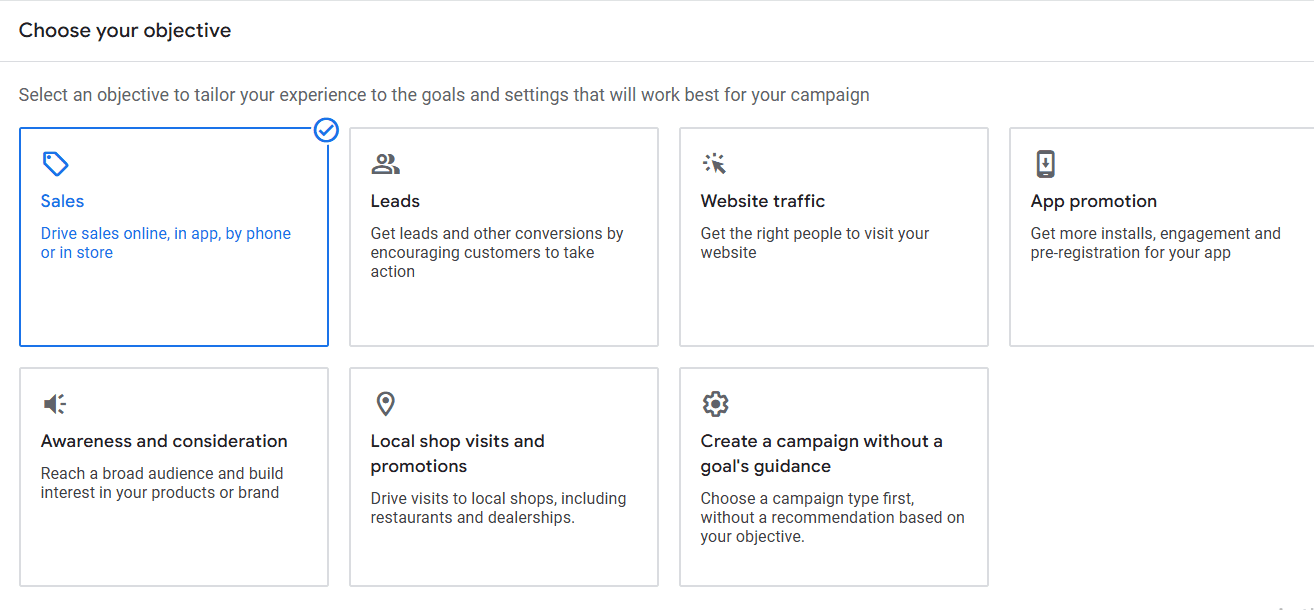
3. Select the “Demand Gen” campaign type:
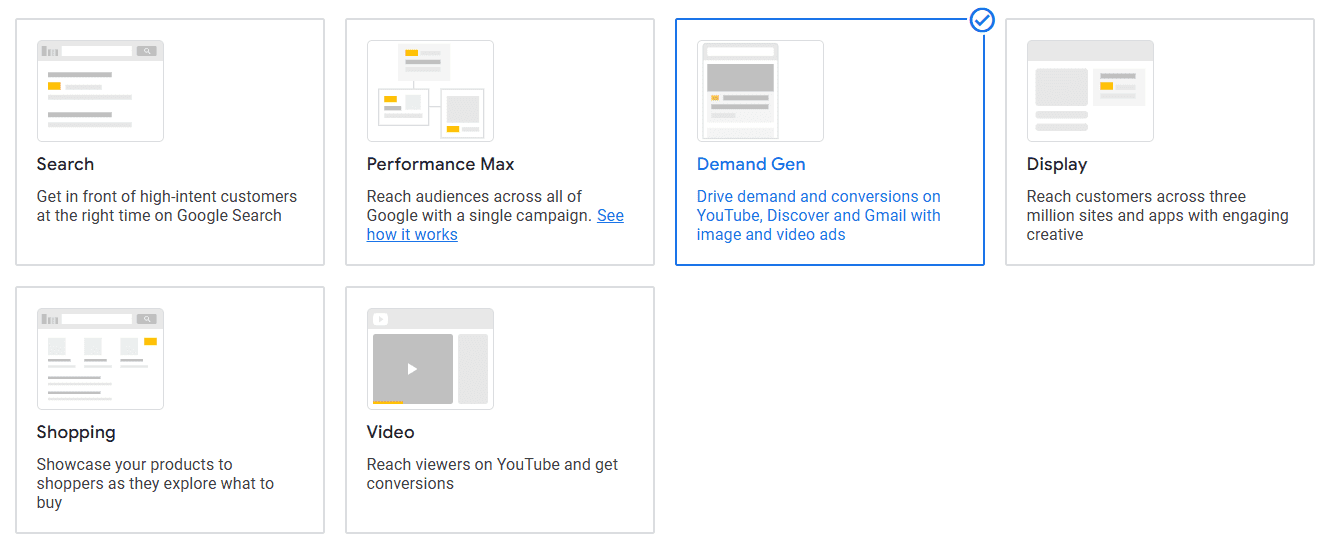
4. Configure your campaign-level settings:
- Give your campaign a clear, consistent name (e.g., “Q3 Prospecting – Video”)
- Choose your performance goal and set your bidding strategy
- Google will prompt you to connect a product feed from the Merchant Center. (
If you want to use product cards, enable this now—you won’t be able to change it later.)
5. Set your daily budget and define your start/end dates. Open Advanced Settings where you can add targeted locations, devices, URL options (tracking templates), ad schedule etc:
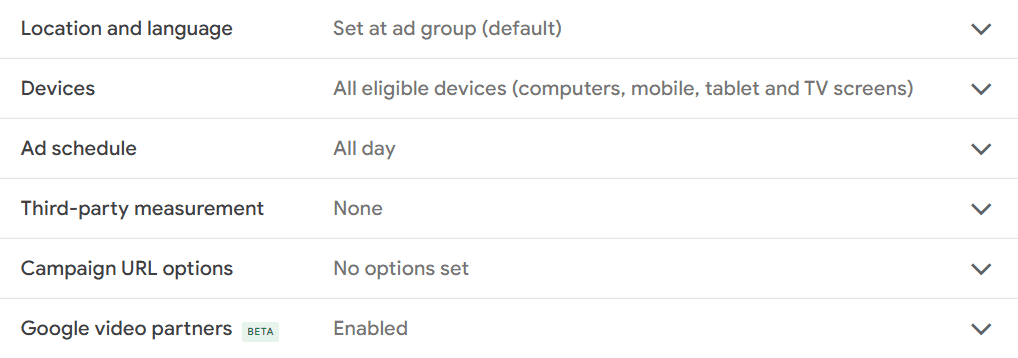
6. Now it’s time to choose who sees your ads.
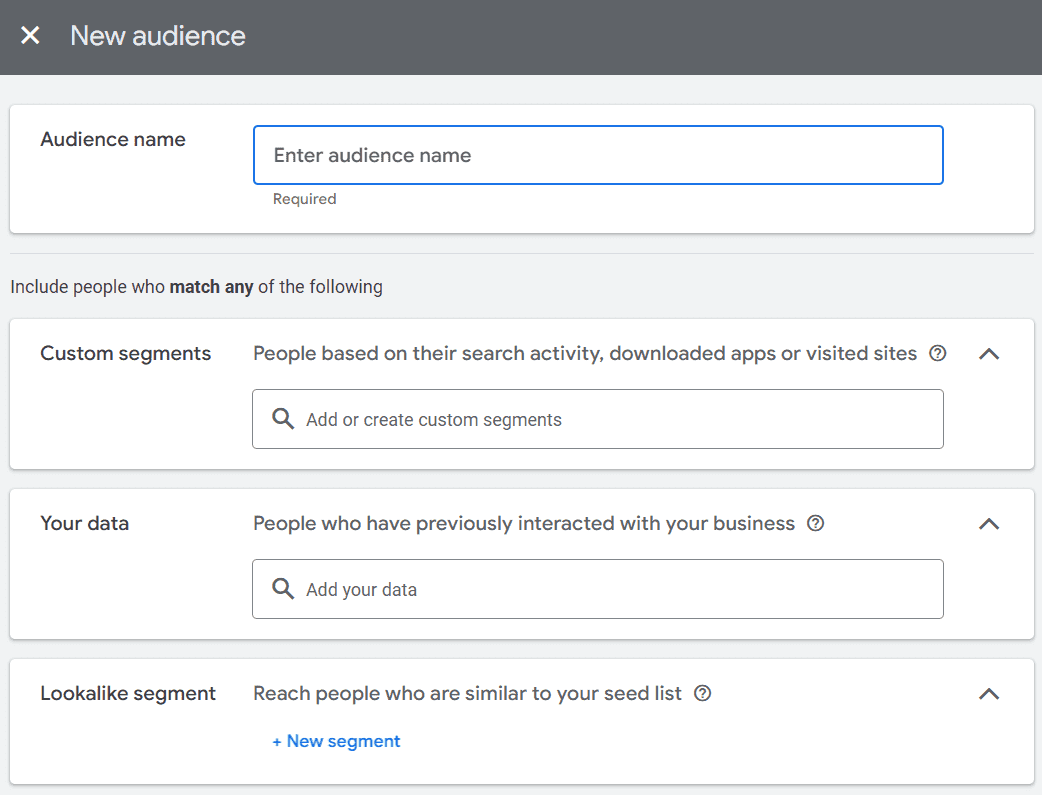
Options for targeting are Custom Segments, Your Data (users who previously interacted for retargeting purposes), Lookalike Segments, Interest & Detailed Demographics (where you can select In-Market Segments, Affinities, Life Events and Detailed Demographics):
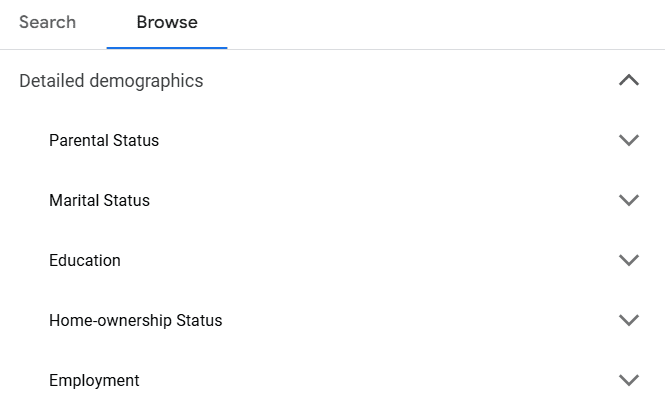
7. You can target a single audience type or combine multiple segments. If you select more than one, Google will merge them into a single targeting group.
One standout feature in Demand Gen is Lookalike Segments — currently only available in this campaign type. Just provide a source audience (like past purchasers or site visitors), and Google will automatically find users who behave similarly:
8. To use lookalikes, you’ll need to have a seed audience ready ahead of time.
You’ll also need to set a coverage level:
- Lower percentages (e.g., 1%) deliver higher similarity but a smaller reach
- Higher percentages (e.g,. 5-10%) expand your reach but reduce precision
Pro tip: Focus on ads between 2–5 minutes long. This is the sweet spot for direct-response YouTube ads—long enough to educate, short enough to convert. Campaigns in this range typically generate significant revenue, not just awareness.
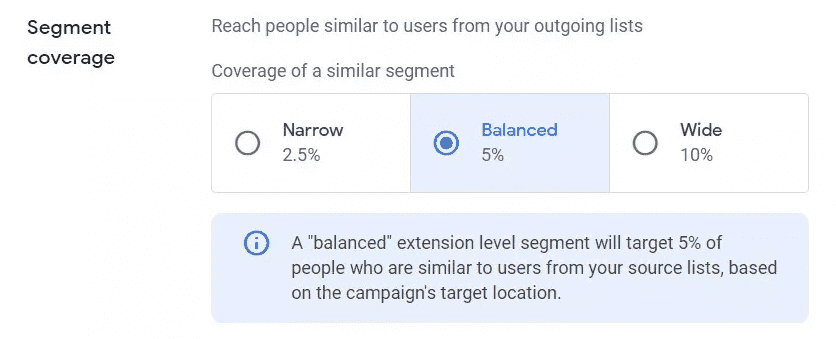
Choose the setting that matches your scale and targeting goals.
 Building Your Demand Gen Ads
Building Your Demand Gen Ads
Now choose your ad format. You can run:
- Single image ads
- Carousel ads
- Video ads

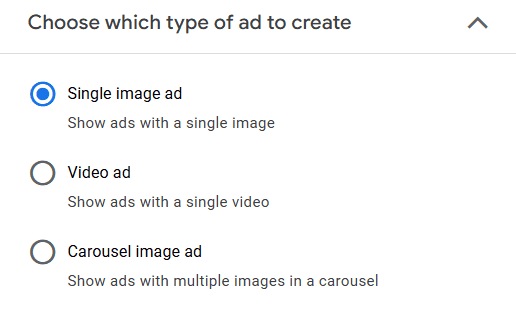
Next, you need to add the main content of the campaign. Different settings are available depending on the ad format:
 Image Ads
Image Ads
- Up to 20 images
- Up to 5 logos
- Up to 5 headlines
- Up to 5 descriptions
- CTA button
- URL + tracking parameters (if needed)
 Video Ads
Video Ads
- Up to 5 videos
- 1 logo
- 5 headlines
- 5 long headlines
- 5 descriptions
- CTA + URL + tracking (optional)
 Carousel Ads
Carousel Ads
- Up to 10 card images
- 1 logo
- 1 headline + 1 description
- Final URL + tracking (if required)
Google will automatically generate ads using the content you’ve uploaded — mixing and matching headlines, descriptions, images, and videos. Over time, it will prioritize the combinations that deliver the strongest performance.
Once everything’s in place, hit Publish, and you’re good to go.
Next Steps: From Zero to Your First YouTube Ad
Feeling inspired? Here’s a simple, battle-tested roadmap to go from blank screen to a high-converting YouTube ad, even if you’ve never run video ads before.

- Sign up for your free VidTao trial
- Search for ads in your industry or audience niche. Save 10-20 ads that instantly catch your attention
- Study their hooks, structure, thumbnails, and CTAs. Bonus: Look for patterns in tone, language, visuals, and pacing

- Use the 4-part formula: Hook → Problem → Solution → CTA
- Keep it conversational, write like you talk
- Focus on one main message per ad
- Draft 3-5 hook variations to test

- Record your voiceover (your phone mic is fine)
- Enhance your audio with Adobe Enhance Speech for a clean, studio-quality sound in one click
- Gather simple, relevant B-roll
- Edit for connection and conversion

- Set up your campaign and launch with a small daily budget ($20-50/day)
- Test different hooks with the same video body
- Monitor watch time and click-through rate
- Scale up the winner, kill the underperformers
- Rinse, rewrite, and retest
Want extra help finding high-performing scripts, hooks, and CTAs? Use VidTao’s ad library to reverse-engineer what’s already working — so you never have to start from scratch.
You’re now set up with the tools to start creating and launching YouTube ads that actually perform.
The next piece of the puzzle? Getting those ads in front of the right people.
That’s exactly what we’ll cover in Part 3 of this guide, where you’ll discover two beginner-friendly campaign types you can launch right away. We'll cover:
- How to repurpose your best-performing Facebook ads into a YouTube Demand Gen campaign
- How to use Performance Max with video to reach new audiences across all of Google’s properties
- Why these setups are the fastest way to gather real data, lower your CPA, and start scaling YouTube ads profitably
- How VidTao helps you shortcut the process by showing you the exact ads your competitors are running right now
By the end of Part 3, you’ll be ready to stop planning and start running campaigns that actually drive results.

